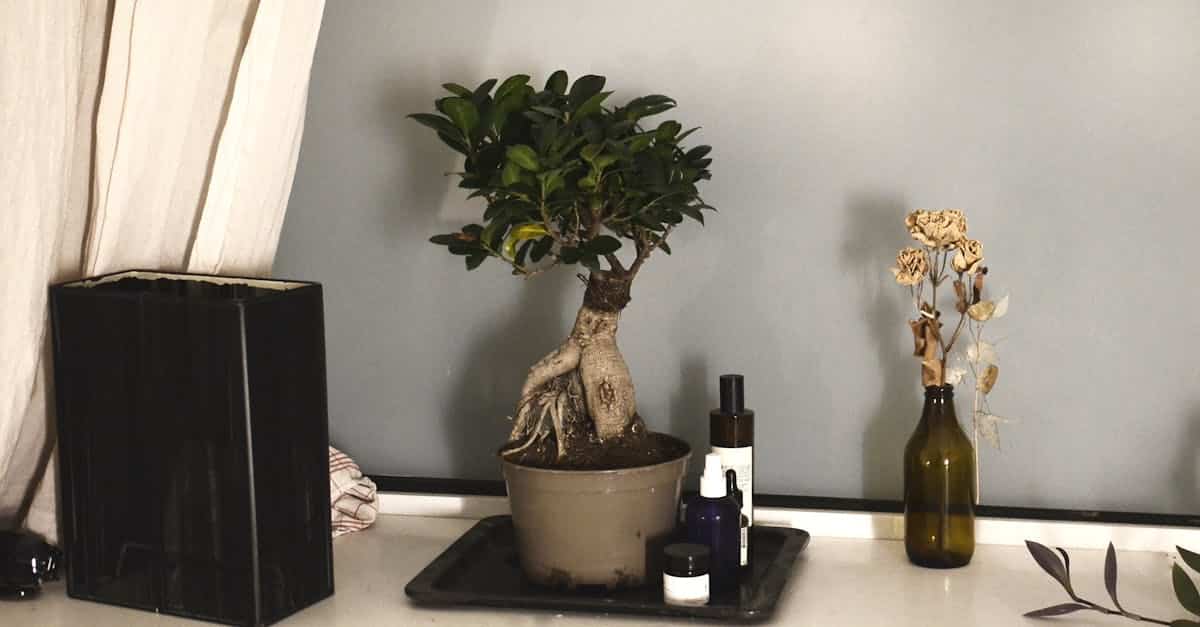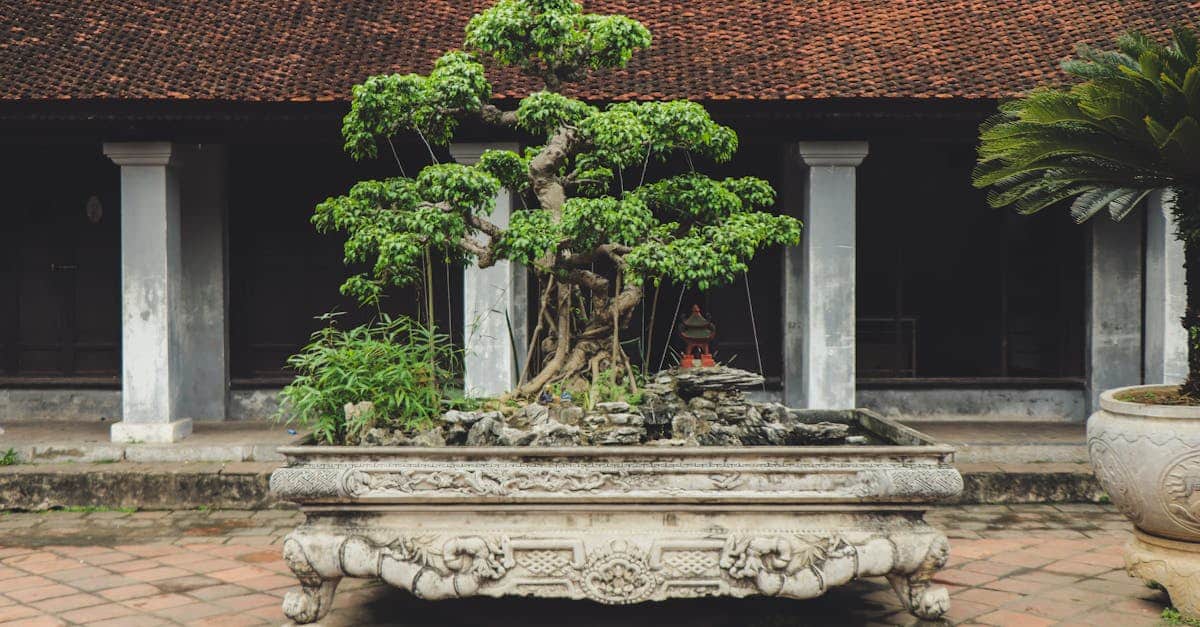Discover the secrets of the worldwide popularity of Japanese bonsai! What are the reasons that make these plant works of art a truly global phenomenon? Immerse yourself in the heart of this age-old art and let yourself be surprised by the magic of Japanese bonsai.
A thousand-year-old Japanese tradition

The Origins of Bonsai
Japanese bonsai, emblems of Japanese culture, find their roots in ancestral techniques of growing trees in pots. It is said that since ancient times, the Chinese already practiced the art of penjing, the ancestor of bonsai. It was only later, in the 12th century, that this tradition was imported to Japan, where it took off to become a pillar of Japanese art and spirituality.
The Philosophy of Bonsai
At the heart of Japanese bonsai practice is a deep philosophy, based on principles such as simplicity, harmony and balance. Bonsai enthusiasts become fully involved in the creation and maintenance of these living works, seeking to reflect the beauty of nature in a small space, while promoting the growth and flourishing of the tree.
The Different Styles of Bonsai
Japanese bonsai come in a variety of styles, each representing a unique interpretation of nature. Some of the most iconic styles include cascading bonsai, straight bonsai, leaning bonsai, semi-cascading bonsai, and many more. Each style embodies a unique aesthetic and invites you to contemplate the splendor of nature from a new angle.
Maintenance and Care of Bonsai Trees
Growing Japanese bonsai requires careful and regular attention. Besides watering and pruning, caring for bonsai also involves exposing them to adequate light, fertilizing them properly, and constantly monitoring their health. Bonsai enthusiasts learn over time the specific needs of each tree species, creating a deep connection with their creations.
The Transmission of the Art of Bonsai
In Japan, the tradition of bonsai is passed down from generation to generation, thus perpetuating unique know-how and sensitivity. Bonsai masters, true guardians of this tradition, teach their disciples not only the cultivation techniques, but also the spiritual values which underlie this art. Thus, Japanese bonsai continue to arouse admiration and wonder throughout the world, perpetuating a thousand-year-old tradition of timeless beauty.
The art of patience and precision

The origins of Japanese bonsai
Japanese bonsai are much more than just a potted plant, they represent a true art and an age-old tradition deeply rooted in Japanese culture. This demanding practice requires great patience, a keen sense of precision and a deep understanding of nature.
Patience: pillar of the art of bonsai
The cultivation of Japanese bonsai is based on patience, a fundamental virtue in the practice of this art. Indeed, the slow growth of dwarf trees requires regular monitoring, careful pruning and constant observation to shape the tree into the desired style. Each gesture requires thought and precision, with the aim of creating perfect balance and harmony.
Precision, the mark of excellence
Precision is at the heart of the art of Japanese bonsai. Each pruned branch, each cut leaf is the result of meticulous attention to detail. The most impressive bonsai are the result of years of meticulous work, where every gesture is thought out to enhance the natural beauty of the tree and create an inimitable living work.
The symbiosis between patience and precision
The combination of patience and precision is what sets bonsaika masters apart from those who try their hand at this delicate art. Each bonsai is a reflection of the unwavering commitment of its creator, his ability to observe, feel and act in perfect symbiosis with nature. This harmony between time and precise gesture gives birth to plant masterpieces that amaze and soothe the soul.
Japanese bonsai embody both the infinite patience of time and the painstaking precision of the human hand. Their culture represents much more than a simple horticultural activity: it is an art in its own right which celebrates the beauty of nature and the mastery of gestures. In growing a bonsai, one learns the value of time, patience and attention to detail, valuable lessons that transcend the art of growing miniature trees.
A symbol of serenity and harmony

Japanese bonsai: A thousand-year-old tradition
Bonsai, the ancestral Japanese art of growing miniaturized trees, is much more than a simple horticultural practice: it is a living work of art that embodies the harmony between man and nature.
Balance and serenity
Japanese bonsai are synonymous with balance and serenity. By growing these dwarf trees, enthusiasts practice a form of active meditation, aiming to create a peaceful and harmonious environment.
Harmony with nature
The very essence of Japanese bonsai lies in their ability to faithfully reproduce nature in miniature. Each branch, each leaf is carefully pruned to respect natural shapes, thus offering a vision of nature in all its splendor.
Patience and contemplation
Creating and caring for bonsai requires infinite patience and deep contemplation. By taking the time to observe and care for these miniature trees, bonsai enthusiasts cultivate a feeling of intimate connection with nature.
Awakening of the senses
Japanese bonsai are a true awakening of the senses, inviting contemplation and full awareness. Their calming presence and harmonious shapes stimulate sight, smell and even touch, offering a unique sensory experience.
Transfer of know-how
Beyond their aesthetic beauty, Japanese bonsai reflect know-how passed down from generation to generation. Each gesture, each size is imbued with tradition and respect for ancient techniques.
Japanese bonsai are not just miniature trees, they are true symbols of serenity and harmony. Their culture requires patience, discipline and sensitivity, offering those who engage in it a valuable lesson in the beauty and balance of nature.
A connection with nature and spirituality
Japanese Bonsai: A Deep Connection with Nature
Japanese bonsai enthusiasts understand that these mini trees are not just potted plants, but true living works of art. The process of creating and caring for a bonsai involves a deep connection with nature. Every gesture, from pruning roots to forming branches, is imbued with meticulous attention to maintaining harmony with the natural environment.
The Art of Cascading Bonsai: A Representation of the Japanese Spirit
Japanese culture places great importance on spirituality and harmony with the universe. The art of cascading bonsai, where the branches extend downward like a waterfall, reflects this state of mind. This form of bonsai embodies subtlety, balance and grace, inviting contemplation and meditation.
The symbolism of Japanese bonsai: A source of spiritual inspiration
Each element of a Japanese bonsai has deep symbolic meaning. From the shape of the trunk to the nuances of the leaves, everything is carefully considered to convey spiritual values. Thus, contemplating a bonsai can provide a feeling of serenity and unity with nature, inviting you to an inner journey marked by tranquility.
The practice of bonsai: A way to cultivate the soul
Beyond aesthetics, the practice of Japanese bonsai is an art that cultivates the soul. By caring for a bonsai, observing its slow growth and adapting to its changing needs, one learns patience, perseverance and humility. This approach invites quiet introspection, listening to oneself and one’s environment.
Japanese bonsai are not simply miniature plants, but witnesses to the intimate relationship between man and nature. Through their beauty and symbolism, they remind us of the importance of taking the time to cultivate our connection with the world around us. By practicing the art of bonsai, we engage in a deep dialogue between nature and spirituality, a path to inner harmony and peace of mind.



